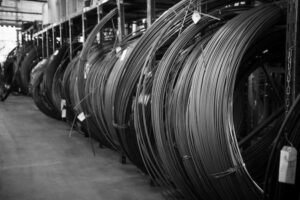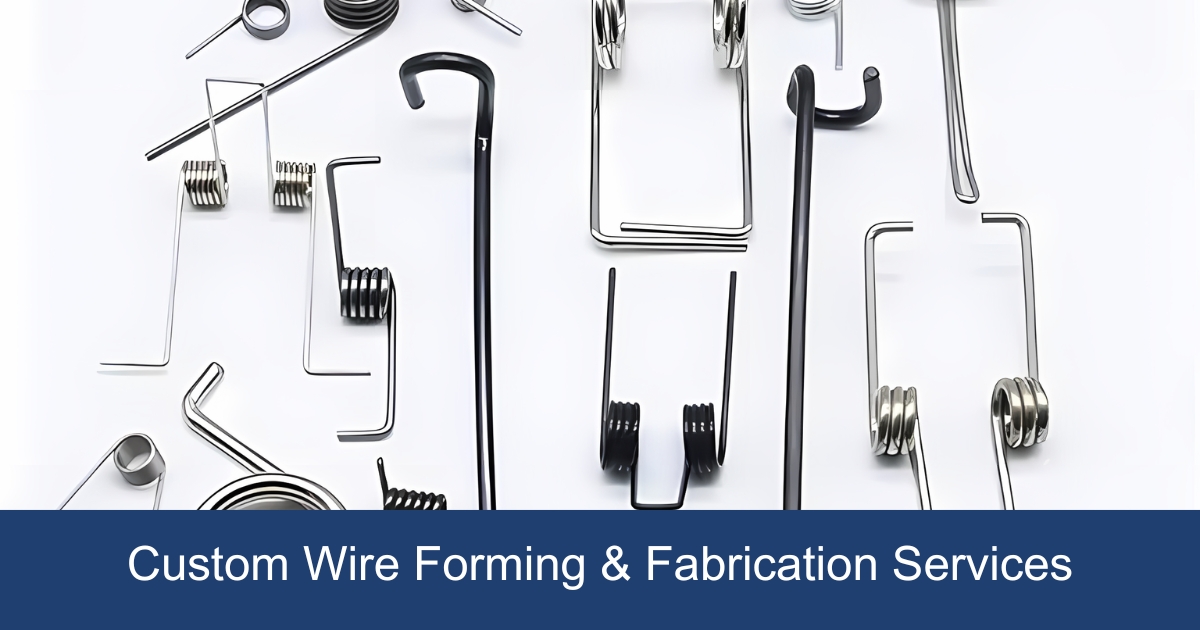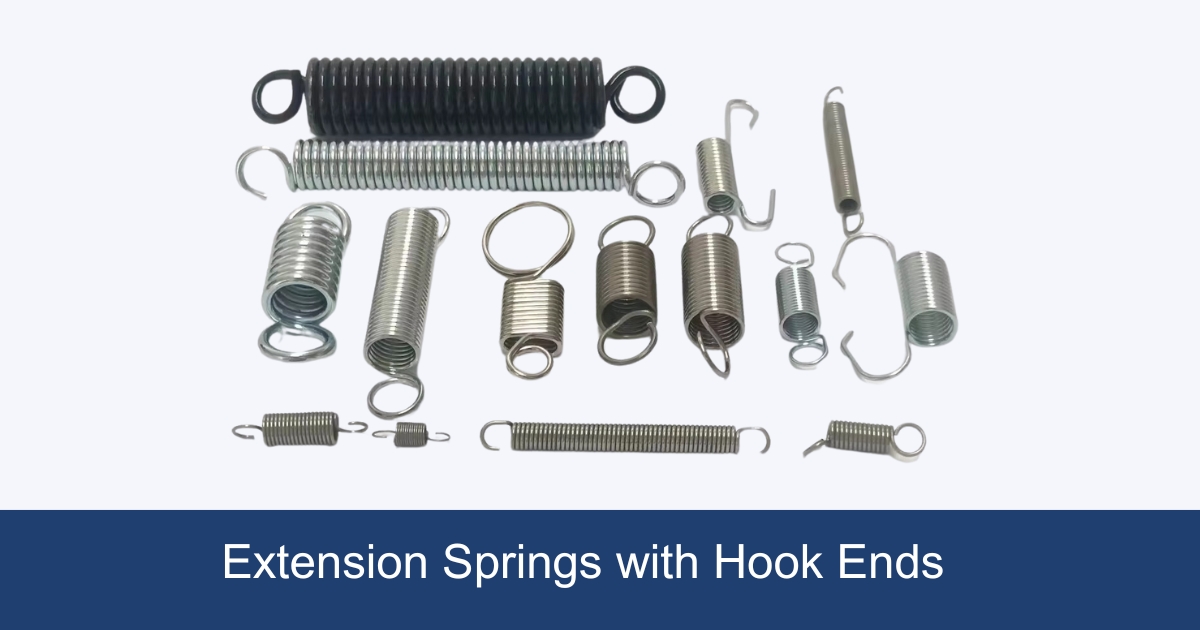Selecting the right compression spring material involves navigating through a plethora of options, such as stainless steel, spring steel material, and specialty alloys like Inconel and beryllium copper, among others. Each material type presents unique properties impacting the spring’s performance in terms of corrosion resistance, tensile strength, and durability. This guide embarks on a systematic exploration of common compression spring materials, delving into their characteristics and how they fare against each other in demanding environments.

Overview of Common Compression Spring Materials
Compression springs, due to their critical role in various applications, can be fabricated from a diverse range of materials, each selected for its unique properties and suitability for specific environments and functionalities. The choice of material significantly influences the spring’s performance, durability, and application suitability. Below is an overview of common materials used in the fabrication of compression springs, highlighting their characteristics and common applications.
Common Compression Spring Materials
- Carbon Steel and High Carbon Steel: Known for their high strength and durability, these materials are widely used for compression springs. High carbon steels, such as music wire, offer excellent tensile strength and are often utilized in demanding applications where high stress and wear resistance are required.
- Applications: Automotive, industrial machinery, and heavy-duty equipment.
- Stainless Steel: This material stands out for its exceptional corrosion and heat resistance, making it ideal for springs used in harsh environments. Stainless steel springs are often found in medical devices, food processing equipment, and marine applications.
- Applications: Medical devices, food processing equipment, marine applications.
- Alloy Steels (Chrome Silicon, Chrome Vanadium): Alloy steels are chosen for their superior strength and elasticity. Chrome silicon and chrome vanadium, for instance, are known for their high tensile strength and excellent shock resistance.
- Applications: Aerospace, military, and high-performance automotive components.
- Non-Ferrous Alloys (Phosphor Bronze, Beryllium Copper, Brass): These materials are selected for specific properties such as electrical and thermal conductivity (phosphor bronze and beryllium copper) and corrosion resistance (brass). They are commonly used in electrical components and corrosive environments.
- Applications: Electrical components, marine, and chemical processing equipment.
- Specialty Materials (Titanium, Inconel): Titanium and Inconel are used for their unique properties, such as lightweight strength and high-temperature resistance, respectively. These materials are often reserved for specialized applications such as aerospace and high-temperature industrial processes.
- Applications: Aerospace, medical implants, and high-temperature industrial applications.
Finishing and Coating Options
To enhance the performance and longevity of compression springs, various finishing and coating techniques are employed. These treatments can improve corrosion resistance, electrical conductivity, and aesthetic appeal, among other properties.
- Plating (Zinc, Nickel, Chrome): Offers additional corrosion resistance and aesthetic appeal.
- Powder Coatings and E-Coating: Provide durable, long-lasting protective layers against environmental factors.
- Black Oxide and Anodizing: Improve corrosion resistance and surface hardness.
Selecting the appropriate material and finishing for a compression spring requires a comprehensive understanding of the application environment, including factors such as temperature, corrosive potential, and mechanical stress. This knowledge ensures the optimal performance and longevity of the compression spring in its intended application.
High Carbon Steel Used in Compression Springs
High carbon steel, particularly music wire, stands as the premier choice for manufacturing compression springs due to its superior strength and durability. Characterized by a carbon content up to 2.1%, high carbon steels surpass regular carbon steels in strength, facilitated by their higher carbon percentage. This allows for the material to be tempered to achieve higher hardness levels, enhancing its wear resistance. The intrinsic carbon content enables these steels to undergo heat treatment processes, further hardening the material and making it more resilient to wear and tear. This resilience is crucial in applications where springs are subjected to high-pressure environments, necessitating materials that can withstand significant stresses without failure.
The versatility and economic efficiency of high carbon steel make it a preferred material among businesses for spring manufacturing. Music wire, a type of high carbon spring steel, is particularly lauded for its high tensile strength and elasticity. This material is not only competitively priced but also offers flexibility, making it suitable for a wide range of applications. High carbon steel springs can be tailored to meet specific project requirements, providing an adaptable solution for various mechanical needs. These springs exhibit excellent strength and hardness properties, along with good elastic properties, allowing them to deform under stress and return to their original shape once the stress is removed. Additionally, their wear resistance minimizes surface damage or deformation over time, ensuring longevity and consistent performance.
To provide a clearer understanding of the specifications and capabilities of high carbon spring wire, the following table outlines the tensile strength of various high carbon spring wire materials and their recommended applications:
| High-Carbon Spring Wire Material | Tensile Strength (lbs/in) | Recommended Applications |
|---|---|---|
| Music Wire ASTM A228 | 230-399 | General-purpose springs, automotive, industrial |
| Hard Drawn ASTM A227 | 147-283 | Heavy-duty springs, agricultural equipment |
| High Tensile Hard Drawn ASTM A679 | 165-293 | Aerospace, military components |
| Oil Tempered ASTM A229 | 165-293 | Automotive valve springs, industrial machinery |
| Carbon Valve ASTM A230 | 215-240 | High-pressure valve springs, energy sector |
It’s important to note that while high carbon spring wire offers numerous advantages, it is not recommended for temperatures exceeding 250ºF (121ºC) or for exposure to moist or corrosive environments. This limitation underscores the importance of selecting the appropriate material based on the specific conditions and requirements of the application.
Stainless Steel Used in Compression Springs
Stainless steel is renowned for its corrosion resistance and ability to withstand high temperatures, making it an ideal choice for compression springs in demanding environments. The properties of stainless steel compression springs extend beyond mere resistance to rust; they embody a blend of durability, tensile strength, and aesthetic appeal. This section delves into the characteristics of stainless steel as a material for compression springs, focusing on its mechanical properties, temperature resilience, and suitability for specific applications.
Mechanical Properties and Grades:
- Tensile Strength: Stainless Steel Wire materials such as Stainless Steel 302 ASTM A313, Stainless Steel 17-7 ASTM A313, and Stainless Steel 316 ASTM A316 demonstrate a range of tensile strengths, making them adaptable to various mechanical requirements.
- Stainless Steel 302 ASTM A313: 125-325 lbs/in
- Stainless Steel 17-7 ASTM A313: 110-245 lbs/in
- Stainless Steel 316 ASTM A316: 235-335 lbs/in
- Corrosion Resistance: Stainless Steel 302 and 316 are particularly resistant to corrosion, while Stainless Steel 17-7 combines hardness with high tensile strength, offering an excellent choice for environments prone to wear and tear.
- Application Suitability: The non-magnetic nature of austenitic stainless steels, like 304 and 316, makes them suitable for electronic and electromagnetic applications, enhancing their versatility across industries.
Temperature and Environmental Resilience:
- Stainless steel compression springs can maintain their mechanical properties across a wide temperature range, resisting deformation in both high and low-temperature conditions. This attribute is critical for applications in the medical field and high-temperature industrial processes, where material stability is non-negotiable.
- High Temperature Conditions: Stainless steel can resist temperatures as high as 550º F (288º C), making it an excellent choice for applications subjected to high heat.
- Humid and Corrosive Conditions: The inherent corrosion resistance of stainless steel allows these springs to perform reliably in humid or corrosive environments, ensuring longevity and consistent performance.
Applications Across Industries:
- Medical Industry: The biocompatibility and hygienic characteristics of stainless steel make it a preferred material in medical applications, where cleanliness and resistance to bacteria are paramount.
- Food Processing and Handling: Stainless steel’s resistance to moisture and rust suits it for food processing environments, where maintaining hygiene standards is critical.
- Energy Industry: The material’s resistance to corrosion, chemicals, and heat finds applications in oil and gas platforms, pipelines, and renewable energy sources, where durability under harsh conditions is essential.
- Transportation: In the automotive, aerospace, rail, and marine industries, stainless steel springs are used for their durability and resistance to environmental factors, contributing to the safety and reliability of transportation systems.
In summary, stainless steel stands out as a preferred material for compression springs, offering a combination of mechanical strength, temperature resilience, and environmental resistance. Its versatility across various grades allows for tailored applications, meeting the specific needs of industries ranging from medical to energy, transportation, and beyond.
Alloy Steel Used in Compression Springs
Alloy steel springs are engineered to meet the demands of heavy or high-stress applications, leveraging their exceptional strength and improved corrosion resistance over carbon steel springs. This section explores the advantages of using alloy steel in compression springs, focusing on their heat treatment capabilities, the specific types of alloy steels used, and their applications.
Heat Treatment and Corrosion Resistance
- Alloy steel springs can undergo heat treatment processes to achieve desired mechanical properties, such as increased tensile strength or improved wear resistance. This adaptability allows engineers to tailor the spring material to meet specific requirements of the application.
- Compared to carbon steel springs, alloy steel variants exhibit better corrosion resistance, ensuring longevity and reliability in environments that may be challenging or corrosive.
Types of Alloy Steel Springs and Their Properties
| Alloy Steel Type | Tensile Strength (lbs/in) | Maximum Working Temperature | Recommended Conditions |
|---|---|---|---|
| Chrome Vanadium ASTM A231 | 190-300 | – | High stress and shock load applications |
| Chrome Silicon ASTM A401 | 235-300 | 475ºF (248ºC) | High temperature environments; not recommended for humid conditions |
- Chrome Silicon and Chrome Vanadium: These high tensile-strength chromium alloy steels are notable for their ability to withstand significant stresses and high temperatures. Chrome silicon, in particular, is superior to music wire in terms of high-temperature endurance and strength, making it suitable for demanding applications. However, it is not recommended for use in humid conditions due to potential corrosion issues.
- Oil-Tempered Alloys: Including oil-tempered chrome vanadium and oil-tempered chrome silicon, these materials are used for their excellent strength and elasticity, which are critical in automotive suspensions and other high-performance applications.
Applications and Considerations
- Alloy steel springs are integral to the functionality of automotive suspensions, aerospace components, and military hardware, where their superior strength and resilience to high temperatures and stresses ensure optimal performance.
- It is crucial to consider the specific environment and mechanical demands of the application when selecting an alloy steel spring. For instance, chrome silicon is preferred for high-temperature applications, whereas chrome vanadium may be chosen for its shock resistance in automotive and military applications.
- Awareness of potential issues, such as stress fractures and the risk of cracking during the straightening process, is essential for ensuring the longevity and reliability of alloy steel springs in their respective applications.
In summary, the selection of alloy steel for compression springs offers a versatile and robust solution for applications requiring high strength, corrosion resistance, and temperature resilience. By carefully considering the specific requirements and potential challenges of each application, engineers can harness the full potential of alloy steel springs to enhance performance and durability.
Specialty Materials for Compression Springs
In the realm of compression springs, the selection of material is pivotal for ensuring optimal performance across various applications. Specialty materials, such as Inconel, Elgiloy, Titanium, and an array of nickel alloys including Hastelloy and Monel, cater to specific needs ranging from high temperature resistance to non-magnetic properties. Additionally, plastics like nylon and PTFE offer alternatives where metal springs may not be suitable. Below is a detailed exploration of these materials, highlighting their unique properties and applications:
Specialty Metal Alloys:
- Inconel: Known for its remarkable strength at high temperatures and resistance to oxidation and corrosion, Inconel is ideal for aerospace and automotive applications where durability under extreme conditions is crucial.
- Elgiloy: This cobalt-chromium-nickel alloy offers excellent corrosion resistance, high strength, and durability, making it suitable for marine and medical applications.
- Titanium: With its high strength-to-weight ratio and resistance to corrosion, Titanium is preferred for lightweight and high-strength applications such as in the aerospace and sporting goods industries.
- Nickel Alloys (Hastelloy, Monel): These alloys are chosen for their exceptional corrosion resistance, especially in harsh chemical environments, making them suitable for chemical processing equipment.
Plastics:
- Nylon: Offers excellent wear resistance, low coefficient of friction, and good fatigue resistance, ideal for applications requiring lightweight and corrosion-resistant springs.
- PTFE (Polytetrafluoroethylene): Known for its outstanding chemical resistance, PTFE is used in applications where metal springs would fail due to chemical attack.
Applications and Considerations:
| Material | Key Properties | Common Applications |
|---|---|---|
| Inconel | High temperature resistance, corrosion resistance | Aerospace, automotive |
| Elgiloy | High strength, excellent corrosion resistance | Marine, medical |
| Titanium | High strength-to-weight ratio, corrosion resistance | Aerospace, sporting goods |
| Hastelloy | Exceptional corrosion resistance | Chemical processing |
| Monel | Excellent corrosion resistance, good strength | Marine, chemical processing |
| Nylon | Wear resistance, low friction | Lightweight, corrosion-resistant springs |
| PTFE | Outstanding chemical resistance | Chemical processing, where metal fails |
The first step in designing a compression spring involves determining its dimensions and material type, crucial for the spring’s functionality and cost-effectiveness. Dimensions include the inner and outer diameters, end types, and free length, where the inner diameter is calculated by subtracting two wire diameters from the outer diameter, and the outer diameter is calculated by adding two wire diameters to the inner diameter. Various end types are available, including closed and squared ends, closed and ground ends, double closed ends, and open ends. Selecting the right material type, such as Music Wire ASTM A228, Stainless Steel 302 A313, Beryllium Copper, Phosphor Bronze, Monel, Inconel, and Copper, is crucial for ensuring the spring meets the specific requirements of its intended application.
In conclusion, the selection of specialty materials for compression springs is guided by the specific needs of the application, including operating temperatures, corrosive conditions, and mechanical properties. Understanding these materials’ unique properties allows for the design of compression springs that are not only functional and cost-effective but also tailored to meet the rigorous demands of their intended applications.
Factors Influencing Material Selection
When selecting the appropriate material for a compression spring, several critical factors must be considered to ensure the spring meets the specific requirements of its intended application. These factors are instrumental in determining the spring’s performance, durability, and overall effectiveness in various environments.
Performance and Durability Factors:
- Travel Limitations and Maximum Load: These are dictated by the spring’s physical dimensions and material, with the maximum load considering solid height being a critical threshold not to exceed to avoid breakage or permanent deformation.
- Spring Rate: This defines the force of the compression spring and is a crucial aspect of its performance.
- Fatigue Resistance: Materials with high fatigue resistance are preferred for applications involving cyclic loading and unloading.
- Corrosion Resistance: Essential for ensuring long-term performance, especially in environments prone to causing material degradation.
Application-Specific Considerations and Material Selection:
- High-Temperature and Corrosive Environments: Select materials that can withstand extreme conditions without compromising the spring’s integrity.
- Cost and Availability: These practical considerations can influence material choice, balancing between performance requirements and project budget constraints.
- Custom vs. Stock Springs: While stock springs are useful for prototyping or replacements, custom springs tailored to specific requirements are better suited for production quantities.
Table: Key Considerations for Compression Spring Material Selection
| Factor | Consideration | Impact on Selection |
|---|---|---|
| Environmental Conditions | Temperature, moisture, UV exposure | Material type with appropriate resistance |
| Physical Dimensions | Outer diameter, inner diameter, free length, solid height | Ensures proper fit and operational stability |
| Performance Requirements | Travel limitations, maximum load, spring rate | Dictates material strength and elasticity |
| Durability and Longevity | Fatigue resistance, corrosion resistance | Influences material choice for longevity |
| Practical Aspects | Cost, availability, custom vs. stock options | Balances performance with budget and timeline |
Impact of Material on Compression Spring Performance
The performance of a compression spring is significantly influenced by the material from which it is made. This impact is observed across several key parameters, including the spring’s force production, resistance to deformation, and longevity under repetitive stress. To elucidate these relationships, the following points and table provide a structured overview:
- Spring Force and Rate:
- The force a compression spring produces is directly proportional to its compression level, governed by the spring rate or spring constant. This characteristic determines how much load a spring can support before reaching its elastic limit.
- Resistance to Deformation and Fatigue:
- Yield strength is critical for a spring’s resistance to deformation. Materials like high carbon steel and titanium are favored for their high yield strengths.
- Fatigue strength is indicative of a material’s endurance under repetitive stress, which directly influences the spring’s lifespan. Materials with high fatigue strength are less likely to fail prematurely.
- Corrosion Resistance and Surface Quality:
- Corrosion resistance is vital for maintaining the spring’s integrity over time, particularly in hostile environments. This property prevents rust and chemical degradation.
- Surface treatments such as shot-peening enhance the spring’s surface, reducing the likelihood of fatigue cracks spreading.
To further illustrate these points, the table below compares key material properties and their impact on compression spring performance:
| Material Property | Impact on Compression Spring Performance |
|---|---|
| Spring Rate (Spring Constant) | Determines the spring’s force, influencing how much load it can support and its suitability for specific applications. |
| Yield Strength | High yield strength materials offer better resistance to deformation, essential for springs subjected to high loads. |
| Modulus of Elasticity (Young’s Modulus) | Affects the spring’s stiffness and response to applied forces, with higher values indicating stiffer materials. |
| Fatigue Strength | Materials with high fatigue strength are preferable for applications involving cyclic loading, as they are less likely to fail under repetitive stress. |
| Corrosion Resistance | Essential for springs used in corrosive environments, ensuring longevity and reliability by preventing rust and chemical degradation. |
| Surface Treatments (e.g., Shot-Peening) | Improves surface quality and fatigue resistance, making it harder for cracks to propagate and extend the spring’s usable life. |
Regular inspection and maintenance are crucial to sustaining the spring’s performance and safety. Over-compressing a spring beyond its designed limits can lead to premature failure, highlighting the importance of understanding and adhering to the material’s properties and the spring’s design specifications. This careful consideration ensures that compression springs can effectively perform their functions—whether that’s preventing movement, applying continuous pressure, or returning a component to its original position—while remaining lightweight, affordable, and requiring minimal maintenance.
FAQs
What is a compression spring made of?
Compression springs are typically made from materials like high-carbon steel, stainless steel, music wire, chrome silicon, and phosphor bronze, chosen for their strength, durability, and specific application requirements.
What material is used for helical compression springs?
Helical compression springs are often made from high-carbon steel (spring steel), stainless steel, or music wire, depending on the required strength, corrosion resistance, and environmental conditions they will face.
What does a compressed spring have?
A compressed spring possesses stored potential energy due to the force applied to compress it, which it can release to return to its original shape when the force is removed.
How can the strength of a compression spring be increased or decreased?
To modify the strength of a compression spring, the key is to adjust the ratio between the wire diameter and the overall spring diameter. Using a thicker wire or reducing the coil diameter increases the spring rate, making the spring stronger. Conversely, using a thinner wire or increasing the coil diameter decreases the spring rate, resulting in a weaker spring force.



